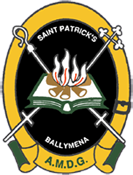KS4
Key Stage 4:
Examination Board: CCEA
Mathematics reveals hidden patterns that help us understand the world around us. Nowadays, Mathematics is not just about arithmetic and geometry, it teaches us the techniques we need to problem solve in the modern world. Every discipline uses mathematics, from engineering and science to the world of business and the financial sector.
Mathematics remains a compulsory subject at GCSE because employers recognise the need for today’s work force to deal with numerical data, and to be able to understand mathematical models. While most pupils will work towards a GCSE in years 11 and 12, the occupational studies group will do level 1 and level 2 essential skills.
The teaching and assessment of GCSE Mathematics changed in September 2017. Whilst the specifications are still in draft format the aims are as follows and are unlikely to change dramatically: -
· develop fluent knowledge, skills and understanding of mathematical methods and concepts;
· acquire, select and apply mathematical techniques to solve problems;
· reason mathematically, make deductions and inferences and draw conclusions; and
· comprehend, interpret and communicate mathematical information in a variety of forms appropriate to the information and context.
Specification
The tables below summarise the assessment structure of the course. Each paper includes structured questions, questions set in contest and some requiring unprompted solution of multistep questions.
Foundation Tier
|
Assessment Components |
Assessment |
Target Grades |
Weighting |
|
Unit M2 *Students should know the content of unit M1 before taking this unit |
External Examination with calculator 1h 45 mins |
C |
45% |
|
Unit M6 (Foundation completion test) *Students should know the content of unit M1, M2 & M5 before taking this unit |
Two external written examinations 1hr 10 mins: Paper 1 without calculator Paper 2 with calculator |
C |
55% |
Higher Tier: Option 1
|
Assessment Components |
Assessment |
Target Grades |
Weighting |
|
Unit M3 *Students should know the content of unit M1 & M2 before taking this unit |
External Examination with calculator 2 hours |
B, C |
45% |
|
Unit M7 (Higher completion test) *Students should know the content of unit M1, M2, M3, M5 & M6 before taking this unit |
Two external written examinations 1hr 15 mins: Paper 1 without calculator Paper 2 with calculator |
B, C |
55% |
Higher Tier: Option 2
|
Assessment Components |
Assessment |
Target Grades |
Weighting |
|
Unit M4 *Students should know the content of unit M1, M2 & M3 before taking this unit |
External Examination with calculator 2 hours |
A*, A, B, C |
45% |
|
Unit M8 (Higher completion test) *Students should know the content of unit M1, M2, M3, M4, M5, M6 & M7 before taking this unit |
Two external written examinations 1hr 15 mins: Paper 1 without calculator Paper 2 with calculator |
A*, A, B, C |
55% |
Important:
It is possible to interchange units ie a pupil may do M4 and M7 if it increases their chances of getting a better grade.
CEA report the results of individual assessment units on a uniform mark scale that reflects the assessment weighting of each unit. They determine the grades awarded by aggregating the uniform marks that candidates obtain on individual assessment units and their completion test. (There is currently no more detail on this. The table below shows the conversion table for current specification. The new specification will follow a similar principle.)
Through the mathematics content, pupils will:
- develop their mathematical knowledge, in part through solving problems and evaluating the outcomes, including multi-step problem
- develop their use of formal mathematical knowledge to interpret and solve problems, including in financial mathematics
- begin to model situations mathematically and express the results using a range of formal mathematical representations
- select appropriate concepts, methods and techniques to apply to unfamiliar and non-routine problems
OCNI Level 1 and 2 Essential skills is taught in the transition group and there is a chance to repeat GCSE Mathematics in Year 13 and 14.

